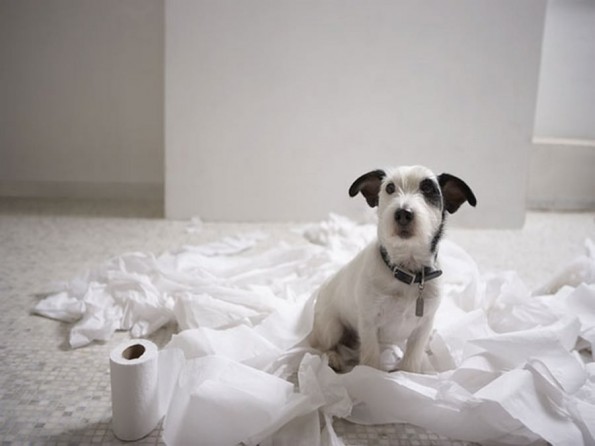
As a pet owner, you are probably familiar with some of the most common behavior problems in pets but do you ever find yourself questioning why pets act this way? In this article we will discuss common behavior problems in pets, some reasons for their actions, and tips to help correct the problem.
Destructive chewing can be credited to a number of reasons. Primarily, pets tend to chew when they are bored, teething, or feel nervous or anxious. Make sure your pet has time to play and exercise each day in order to release their pinned-up energy. There are also toys available with hidden treats inside to help keep your pet stimulated. Make sure the toy is well built, size appropriate, and indestructible to prevent your pet from swallowing any pieces. As a last resort, there are medications available for a veterinarian to prescribe to help with chewing related to anxiety.
Urine Marking serves as a form of communication for a dog. Claiming territory, defining the hierarchy, or announcing their mating availability are just some of the messages they may be trying to convey. Sometimes dogs also using marking to make their environment smell more like home. Spaying or Neutering your pet at a young age greatly reduces the chance of marking. It is also very important to eliminate any odor if your dog has previously marked a spot. Try to use a cleaning product specially designed to eliminate pet odors and scrub the area thoroughly.
Digging is a natural behavioral instinct in dogs. Dogs may dig to try to stay warm or stay cool, entertain themselves, create softer bedding, bury valuables, or hunt small prey. Supervision during outside play is recommend to keep your dog from digging until the problem is corrected. Use a short command such as “Leave it” to help train your dog to leave something alone. Make sure to reward your dog with a treat or praise when they follow the command. Distraction with exercise or items such a food puzzle toys can entertain your dog and possibly keep them from digging.
Although jumping on people can be a frustrating behavior, it is very common in puppies and even adult dogs. This behavior can be eliminated with proper training and rewards for positive reinforcement. Leash training is an important aspect in eliminating this behavior.
It is important to start training your pet to a leash and collar very early in life. There will be an adjustment phase when you begin this training. Most pets don’t automatically like the idea of a collar and may scratch at it or tug/fall when attempting to walk on a leash. Practice makes perfect!
Separation anxiety is one of the most common disorders in household pets. Separation anxiety can be manifested as destructive behaviors, vocalizing excessively, compulsively licking, etc. If you are concerned that your dog or cat suffers from separation anxiety, please call to schedule a consultation with our veterinarians. There are many possible methods to help alleviate/lessen this condition.
Unfortunately, eating stool is common behavior reported in dogs. Most of the time, there is no nutritional deficiency involved in this, however an appropriate nutritional evaluation should be performed in these cases. If you are experiencing this problem with your pet, call our office to discuss the use of a food additive (For-Bid) that helps to eliminate this behavior.
Aggressive behaviors in dogs should be taken seriously and the underlying cause of the aggression should be addressed. Please watch our Feedback Friday video on Dog Aggression for more tips and information.
The most important thing to note when potty training your new puppy is BE PATIENT and BE CONSISTENT. Potty training takes time and every puppy is different. Please watch our Feedback Friday video on Potty Training a Puppy for tricks and tips. Call our office for more information.
It is very important to socialize your puppy as early as possible, both with people and other pets. Always remember that new situations may be overwhelming to your puppy, so introduce these scenarios as carefully as possible and pay attention to any signals that your pet may give that he/she is uncomfortable. Please watch our Feedback Friday video on Socializing Your Pet for more tips and information.
Clawing furniture/objects is a common behavioral problem in cats. To some degree, this is a natural behavior for cats. Always have a scratch pad/post or some type of material available for your cat to use instead of furniture. If the problem becomes excessive, please call our office to discuss medical intervention.
Urine marking in cats is a common behavioral problem. It is important to diagnose the underlying reason for this urine marking. Reasons vary from territorial ownership, dislike/discomfort with their surroundings, urinary tract infections, or more significant health problems.
Litter box maintenance is very important for indoor cats. Each household should have one litter box per cat in the household. These litter boxes should be changed/cleaned on a daily basis. If your cat is urinating outside of the litter box, always evaluate for cleanliness in and around the box first.
Aggressive behaviors in cats can be even more unpredictable and difficult to handle than dogs. If your cat is exhibiting aggression, a good overview of environmental stimulants should be performed. We also recommend the use of feline pheromone products to curb aggressive behaviors.
If you have questions or concerns about your pet, one of our staff members will be happy to speak with you. Please call our hospital at 318-473-8177.
